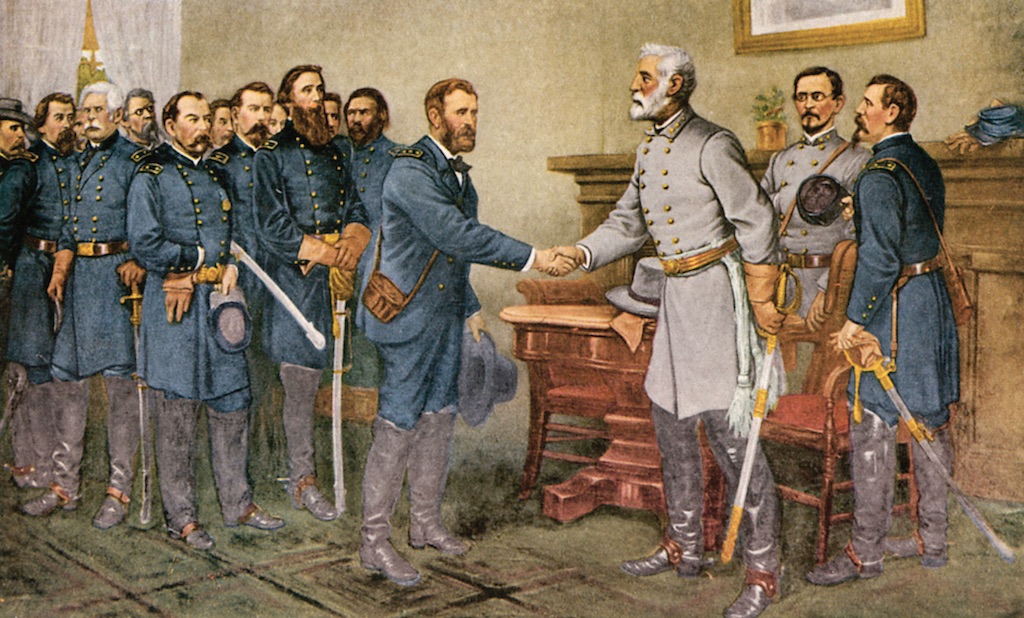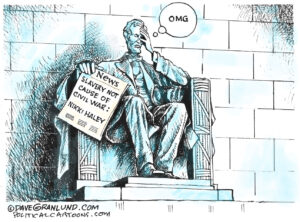The Confederacy Endures
The inconvenient truth is that the military, especially the Army, has long reflected a political and cultural divide in the United States. A reproduction of the "Peace in Union" painting by Thomas Nast. Gen. Robert E. Lee, right, surrenders to Gen. Ulysses S. Grant at the Appomattox Court House in Virginia on April 9, 1865. (Wikimedia)
A reproduction of the "Peace in Union" painting by Thomas Nast. Gen. Robert E. Lee, right, surrenders to Gen. Ulysses S. Grant at the Appomattox Court House in Virginia on April 9, 1865. (Wikimedia)
“There was a right side and a wrong side in the late war, that no sentiment ought to cause us to forget … the South has suffered to be sure, but she has been the author of her own suffering.”
—Frederick Douglass, remarks at Madison Square, New York City (1878)
I’ve always loved to stir the pot. For instance, when I taught American history at West Point (from 2014 to 2016), I amused myself and challenged overwhelmingly conservative students with provocative discussion questions. Here was a favorite: “Who was responsible for more American deaths—Osama bin Laden or Robert E. Lee?” The answer is as obvious as it is (for some) inflammatory. Lee, the West Point graduate and treasonous general, wins the perverse contest by at least a factor of 10. Heck, about as many soldiers from Maine died in the gruesome Civil War as did New Yorkers on 9/11.
Still, strange as it sounds, as recently as 2016, I began my mornings at West Point with a run along Lee Road, through the scenic Lee Housing Area, before grabbing a pre-class haircut in Lee Barracks. These bizarre, if not outright absurd, symbols raise so many questions. Are these commemoratives acceptable, offensive or inappropriate? Are they normal? After all, it is hard to imagine other national militaries offering ubiquitous tributes to the losing side of their civil wars and revolutions. You’ll find no Fort Himmler in Germany or Oliver Cromwell (or, for that matter, King James II) Barracks in the United Kingdom. Oh, how the United States insists on being “exceptional.”
Nevertheless, until the 2015 Emanuel African Methodist Episcopal Church shooting in Charleston, S.C., and the deadly rallies in Charlottesville, Va., in August, such American military dedications seemed curiously normal. I can’t remember a single mention in my four years (from 2001 to 2005) as a young cadet at the military academy.
Truthfully, no one ought to be shocked. The inconvenient truth is that the military, especially the Army, has long reflected a growing political and cultural divide in the United States. There are 10 Army bases named for Confederate generals: Camp Beauregard and Forts Rucker, Benning, Lee, Polk, Bragg, Gordon, Pickett and Hood, as well as my personal “favorite,” Fort A.P. Hill, named after one of Lee’s corps commanders, a man whose troops executed surrendering black Union troops.
Whence They Came
Studies demonstrate that young people are more likely to enlist if they live in close proximity to military bases and communities, which makes perfect sense. Thus, it’s highly significant that there are so many more Army bases per capita in former Confederate states. With the exception of California, the active-duty Army has at most three major bases in what constituted Union states during the Civil War. There are 18 such sites in the former Confederate states. Even in the relatively young (formed in 1947) Air Force, basing is skewed toward the South. Again, discounting California, there are only nine active-duty installations in the Union states, versus at least 29 in the old Confederacy.
At a national level, contemporary culture wars demonstrate the enduring legacy of the North-South divide in politics and culture. Presidential election maps have, in this sense, been remarkably consistent since the Civil War. Secessionist candidates John Breckenridge and John Bell won every future Confederate state in 1860. For nearly a century, the Confederacy was solidly Democratic—a party then traditionally affiliated with segregation and white supremacy. After President Lyndon Johnson had the Civil and Voting Rights Acts passed, Republicans soon dominated in Southern states.
Here’s the rub: Statistically, more soldiers and officers hail from the South, and they’re also more likely to be politically conservative. Since 1968, Republicans have owned the Deep South. Richard Nixon won every former Confederate state in 1972, Ronald Reagan carried all but one in 1980 and the whole South in 1984. So did George H.W. Bush in 1988. Even in defeat, he carried seven of 12 Confederate states in 1992, as did Bob Dole in 1996. More recently, George W. Bush “won” the whole Confederacy in 2000 and 2004. Even in victory, Democrat Barack Obama won just five Southern states between his two elections. Which brings us to 2016, when Donald Trump rode to victory carrying all but one secessionist state.
These very states provide a disproportionate number of new recruits, and the military has (at least since the end of the draft in 1973) been increasingly unreflective of the national demographics. Soldiers, to generalize, are considerably more Southern and rural than the population at large. For example, today, seven of 12 Confederate states rank among the top 20 in per capita military recruits, versus just two of 23 Union states. Most of the others hail from the rural mountain West and such overseas territories as Samoa. That’s a staggering imbalance in a supposedly representative, national institution and one all but certain to influence the culture and attitudes within the martial profession.
A Tragic (Not-So-Hypothetical) Path
So, back to the military, and the human consequences for a not-so-atypical American soldier. Today, in the United States—the world’s “indispensable nation”—a young African-American woman from Montgomery, Ala., might graduate from Jefferson Davis High School (92 percent black and named for the president of the Confederacy), and, awash with patriotic fervor, choose to enlist in the Army. Basic training might then commence at Fort Benning, Ga., whose namesake—Confederate Gen. Henry Benning—said of the war: “The north shall have attained power, the black race will be in a large majority, and then we will have black governors, black legislatures, black juries, black everything. Is it to be supposed that the white race will stand for that?” How lovely.
Being interested in a future career in communications, our brave young woman would then attend advanced individual training at Fort Gordon, Ga. Home of the Army Signal Corps, the fort is named for Gen. John Gordon, who, before the outbreak of war, declared that “slavery is the hand-maiden of civil liberty.” He also led the Georgia branch of the Ku Klux Klan. What a proud commemoration for an installation, especially in an Army officially dedicated to values of “respect, honor, and integrity.”
After several months of training, our new young private might then earn an assignment to one of North America’s largest military bases—Fort Hood, Texas. Gen. John Bell Hood lost a leg and the use of an arm in the service of a secessionist slaveholding republic. Hood so cherished the Confederate battle flag that he enthusiastically exclaimed, “I can assure you, that the gallant hearts that throb beneath its sacred folds will only be content when this glorious banner is planted first and foremost in the coming struggle for our independence.” Isn’t that nice?
Now, some will inevitably argue that the South fought for some vague notion of “state’s rights,” not slavery. There’s so much evidence to refute this claim that a serious scholar is tempted to ignore the contention. But, unable to help myself, I’d ask such readers to consider just one example—Texas’ secession declaration—which unambiguously declared:
We hold as undeniable truths that the governments of the various States, and of the confederacy itself, were established exclusively by the white race, for themselves and their posterity; that the African race had no agency in their establishment; that they were rightfully held and regarded as an inferior and dependent race. …
Others might argue that our young military recruit should quit being such a snowflake and not take offense. But isn’t that a lot to ask of a black youth seeking only to serve her country without being surrounded by, and constantly reminded of, the slave society that sought to defeat America’s Army and enslave her ancestors?
So, how to make it right? Here’s a good, if symbolic, start: Ditch the traitorous, Confederate regalia nonsense. Move these historic symbols where they belong—into museums. Ironically, perhaps the best spokesman for such a policy is Gen. Robert E. Lee himself. After the war, Lee consistently opposed Confederate statues and commemoration, and didn’t want the Confederate battle flag to fly over Washington College—of which he was then president. The military, as one of the few—ostensibly—national institutions, ought to bridge the cultural divide and once again reflect the whole nation, unite disparate individuals and mirror America’s purported values.
E pluribus unum—out of many, one. At least in theory.
The views expressed in this article are those of the author, expressed in an unofficial capacity, and do not reflect the official policy or position of the Department of the Army, Department of Defense or the U.S. government.
Maj. Danny Sjursen is a U.S. Army officer and former history instructor at West Point. He served tours with reconnaissance units in Iraq and Afghanistan. He has written a memoir and critical analysis of the Iraq War, “Ghost Riders of Baghdad: Soldiers, Civilians, and the Myth of the Surge.”
Your support matters…Independent journalism is under threat and overshadowed by heavily funded mainstream media.
You can help level the playing field. Become a member.
Your tax-deductible contribution keeps us digging beneath the headlines to give you thought-provoking, investigative reporting and analysis that unearths what's really happening- without compromise.
Give today to support our courageous, independent journalists.






You need to be a supporter to comment.
There are currently no responses to this article.
Be the first to respond.